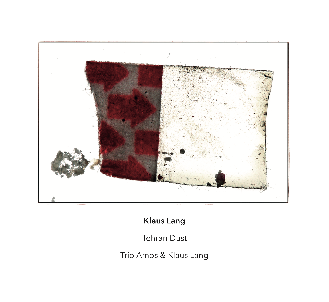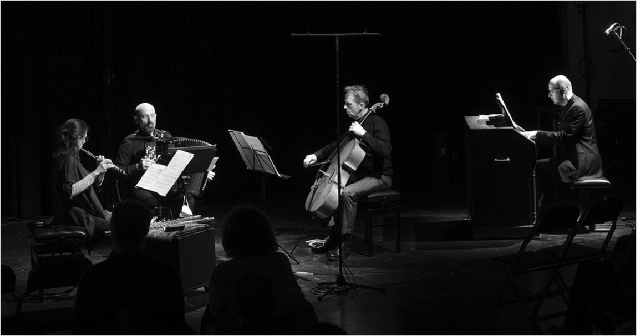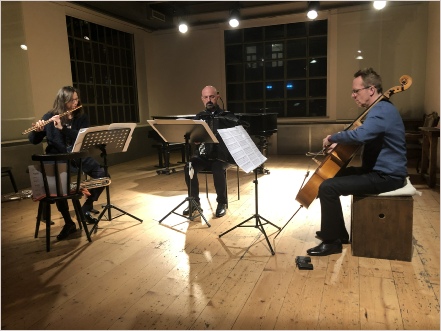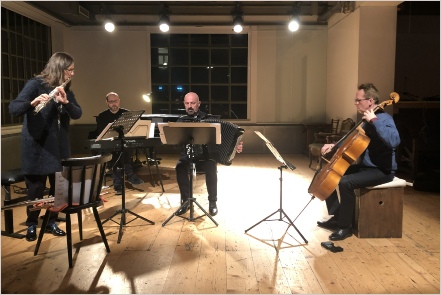Another Timbre TimHarrisonbre

at190 Klaus Lang ‘Tehran Dust’
played by Trio Amos: Sylvie Lacroix (flute), Krassimir Sterev (accordion) & Michael Moser (cello) with Klaus Lang (organ)
1 origami. (2011) 15:31 (flute, cello & accordion) Youtube extract
2 Johannes Ockeghem (arr. Klaus Lang) kyrie (missa prolatium) 5:08
3 tehran dust. (2013) 12:26 (cello & accordion)
4 Pierre de la Rue (arr. Klaus Lang) agnus dei (from Glareanus: dodecacordon) 2:20
5 darkness and freedom. (2017) 25:53 (flute, cello and accordion)
Recorded by Wolfgang Musil at Stift St. Lambrecht, Peterskirche, July 15th& 16th 2019
Liner note by Klaus Lang
The beginning of western philosophy, and the basis for all western art, is grounded in the fascinating intellectual achievement of Pythagoras: to find, by observing the concrete and contingent in nature, a purely abstract principle: numbers. The history of western art is a history of different ways of applying principles found in nature to the creation of art. The combination of structural clarity and beauty with rich sensual quality fascinates me in nature, and that is what I try to achieve in my own work. It is also the principle that I see in the music that I feel closest to: Renaissance music by the likes of Johannes Ockeghem or Pierre de la Rue, that uses the rigour of structure to set free the beauty of sound. But even if we can explain every single note in a canon by Ockeghem, we cannot explain the depth of the sensual experience that we feel when listening to that canon.
Interview with Michael Moser of Trio Amos
Could you tell us about the trio’s collaboration with Klaus? Is it a long-term partnership, or is this the first time that Trio Amos have played Klaus’s music?
The collaboration with Klaus and the individual musicians of Trio Amos goes way back. I, for example, have something like an ongoing multifaceted relationship with Klaus spanning over a period of more than 20 years. He wrote pieces for me as the soloist with chamber orchestra (the queen.the cowboy, 2001) and choir (berge.träume, 2003), together we played his piece for harmonium and cello (tehran.dust, 2013), and in more open settings like ‘werner dafeldecker’s small worlds’ together with John Tilbury, or in concerts of improvised music. In 2018 the ensemble Polwechsel did a collaboration with Klaus and recorded the CD Unseen.
With Trio Amos we have a long-term partnership with Klaus, starting with origami, the first piece he wrote for us in 2011. Continuing with his piece darkness and freedom in 2017 and a new piece for Trio Amos plus piano and harmonium (dreamland, 2020), that we recently premiered together with Klaus and the pianist Tamriko Kordzaia at Hamburg’s Klub Katarakt festival.
Klaus is the opposite of a pushy composer who works hard to hustle and promote his work. So how would you describe his music to someone who doesn’t know it, and what qualities particularly draw you to it?
Klaus’s music is calm, mostly quiet, often barely moving, sometimes fragile but fascinating in terms of sound and textures. He aims to blend all the instruments into a soundscape-like surface where the origin of the produced sound is rendered unimportant. All the instruments involved create more or less one sound. His compositional work mirrors the beauty of ancient proportional methods, but as the individual instrumental sounds become abstract, the underlying structures also disappear, immersed under the texture they create. The goal is to blend all the sounds that you produce into one picture, but that is sometimes hard to achieve, especially in moments with very virtuosic materials. However, the result is always rewarding. It’s not only technique, but also a certain mindset that you have to have, a certain concentration, playing that kind of music, and I think this is something that an audience can clearly feel and appreciate.
Was it the Trio’s idea, or Klaus’s, to include arrangements of works by Ockeghem and De la Rue, and why did you choose to combine these with Klaus’s music?
The idea to include arrangements of renaissance works came from Klaus. In recent years he has often combined his own pieces with Renaissance music in his smaller chamber music concerts, and when he proposed that to us we really liked the idea. Furthermore, his text for the liner notes of this CD underlines the importance of the principle that he sees in the music that he feels closest to: Renaissance music by the likes of Johannes Ockeghem or Pierre de la Rue, that uses the rigour of structure to set free the beauty of sound.
Can you tell us some more about Trio Amos? When was the group formed, and – aside from Klaus’s music – what other composers’ music have you played frequently?
Bringing these instruments and these three musicians together in a long-term trio goes back to an idea Bernhard Lang had. He wrote a piece in his Difference/Repetition series for these three instruments: Difference/Repetition 3. Preceding that, and serving as a founding myth and a source of inspiration, were his series of three solo pieces, Schrift 1, 2, and 3 for flute, violoncello, and accordion. These three Schrift pieces had been conceived as one, to be played continuously with no pause between the pieces, and the composing of DW3 (2000) filled the gap to create an evening long concert programme consisting solely of Bernhard Lang’s music. After this initial spark, and the successful and extensive concert performances resulting from it, the idea developed of expanding the repertoire, which until then consisted of a single composition (Difference/Repetition 3). That was the starting point for the continuous work of Trio Amos.
What is fascinating about Trio Amos, besides the personal skills of the members, is its special sound. It permits delicately nuanced mixtures, along with the fact that the three instruments can be viewed as the smallest form of an orchestra: melody, bass, and harmony.An important aspect of the developmental work of the Trio, along with its striving to collaborate with renowned composers, is the aim of creating a field of dialogue and collaboration with a younger generation of composers. In the summer of 2007, we developed a programme with new pieces by Peter Jakober, Leah Muir and Elisabeth Harnik. And in 2008 the trio performed world premieres of works by Daniel Salecich, Uday Krishnakumar, and Marcel Reuter, followed in 2009/10 by works by Simeon Pironkoff, Angelo Sturiale, and Klaus K. Hübler. World premieres of works by Reinhard Fuchs, Sivan Cohen-Elias, Jean Baptiste Marchand and Klaus Lang’s origami followed in the 2010/11 season. Composers Joanna Wozny and Matthias Kranebitter wrote for Trio Amos, and the trio’s work continued in 2014/15 with the premieres of new pieces by Bernhard Lang (monadologieXXI….. for Franz), Nimrod Sahar (Garden Path (Holzwegeffekt) and Zesses Seglias (trio amoroso, omaggio a Claudio Monteverdi) at the Tzil Meudcan Festival in Tel Aviv. In 2016 the collaboration with Bernhard Lang continued with the world premiere of Monadologie XVIII „Moving architecture“ in the version for voice, flute accordion and cello at the Akademie der Künste, Berlin (with Daisy Press, voice) and Trio Amos premiered Klaus Lang’s new work darkness and freedom at Klangspuren Festival Schwaz 2018.



Michael Moser and Klaus Lang

Trio Amos with Klaus Lang